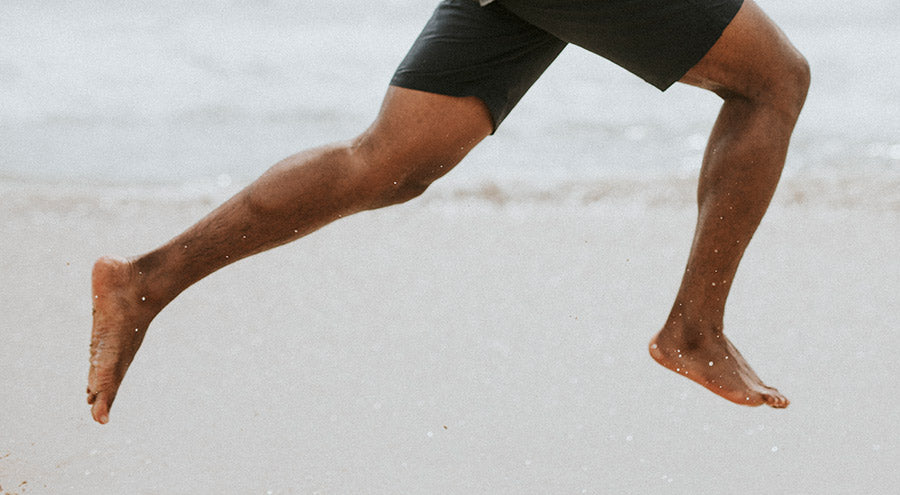Find out what science says about barefoot running. Is it worth it?
The science of barefoot running has gained a lot of followers. But are these shoes really all they’re cracked up to be?
For many years, we have seen athletes from Kenya and Ethiopia win marathon races around the world.
In fact, practically the entire African continent has excellent participation in racing championships and marathons.
But, these two countries in particular stand out.
The question remains: how?
With such precarious training conditions and lack of access to quality materials, how is this possible?
International teams embarked on research and analysis to uncover the secrets behind the success of Kenyan and Ethiopian runners in their sporting competitions.
They sought to understand their methods and strategies, with the aim of deciphering what made them so good compared to other athletes around the world.
They analyzed genetics, biotypes…
And they sinned in the basics: they didn't look down at their bare feet.
Living normally is standing out.

In 2009, Daniel Lieberman, a professor of human evolutionary biology at Harvard University in the United States, carried out tests on runners in Kenya.
In the results, he was able to see that when running barefoot, runners encouraged landing with the forefoot which, in turn, reduced the impact in relation to landing with the heel (using sneakers).
That same year, author Christopher McDougall wrote a book stating that he was “born to run barefoot.” In the bestseller, he recounts his experience of running barefoot after discovering the practice with the Tarahumara indigenous people, native to the mountainous regions of Mexico. After its release, his book sold millions of copies, attracting thousands of people to this “natural” style of running.
And it didn't stop there.
In 2010, the same Harvard professor, Daniel Lieberman, stated that shoes with higher, more cushioned soles were to blame for landing on the heels and weakening the muscles in the feet.
Since then, a real discussion has begun: there are those who are in favor and those who are against.
More than a decade after these studies were published, a wide range of new research has been conducted. The vast majority of this research affirms the strength of the science of barefoot running, proving its unquestionable benefits.
But what does science say?
When running barefoot, the angle of the feet, the biomechanical changes in the stride and the density of the impact are theoretically responsible for making the feet stronger and more sensitive.
Those in favor of the barefoot movement argue that running barefoot reduces the risk of injuries and creates a greater connection with nature, enjoying each sensation when stepping on different surfaces.
Some recent studies from USP show that when running barefoot, it is possible to increase the direct contact of the foot with the ground, caused by greater involvement of the foot and calf muscles during the exercise.
Unlike wearing sneakers, where we often adopt inappropriate running patterns, when running barefoot, we are naturally led to support the midfoot (the middle part), finding greater balance and awareness of space.
Furthermore, the functions of the knee and hip joints gain more efficient and linear movements, reducing the chances of injuries and more serious problems.
For those who oppose the idea, the lack of safety when running barefoot is one of the disadvantages of barefoot running.
Hesitation arises from concern about the lack of protection against the potential risks of the activity.
They argue that when running without shoes, there is a fear of stepping on objects that could hurt the feet without them being previously identified.
Issues such as aesthetics, purchasing options and accessibility were also on the agenda.
FOT came to revolutionize.
The pioneering spirit and expertise of Fábio Jesus, CEO of FOT and Master in Physical Education and Physiology Applied to Human Performance, was responsible for the production of the first barefoot tennis shoe in Brazil.
On one of his trips to the United States, he noticed that high-level athletes performed better when using more minimalist sneakers, which did not yet exist here.
Upon returning to the country, he began the process of developing the brand and sneakers, becoming a national reference in barefoot .
“There are some prerequisites for a shoe to be considered barefoot: it needs to be very flexible, have a wide toolbox, zero drop (the same level throughout the shoe) and from the sole to the insole have a height of 5/6mm. And FOT has them all.”
Through many studies, tests and improvements, today the brand is able to provide incredible experiences for its customers.
The science of barefoot running has been reinvented, and today we can enjoy it in any physical exercise and also in our daily routine.
This is the brand's objective: to experience the freedom of bare feet with protection.
The ideal barefoot for you.
Did you know that:
For every 100g reduction in running shoe weight, we get a 1% gain in running economy.
This is one of the advantages of using sneakers that respect the natural shape of our body.
Because it has a zero-drop sole , your feet stay closer to the ground, reducing the force applied to your tendons and joints. This reduction prevents common illnesses, such as shin splints, from affecting your performance.
A wider toe box provides more space for your toes without having to press against each other. This way, your big toe can occupy its natural space and give your body more balance.
With the ultra-thin and super flexible sole, you can feel anything when you step on the ground. The sensation is like bare feet, but with protection, giving more stability to the body and greater sensitivity to touch.
And it goes further.
Barefoot tennis reconnects you with nature and teaches you to live freely.
Every day, you will feel freedom in every movement of your feet, knowing that they will be protected.
Fun fact: bare feet win the Olympics.
Abebe Bikila is an Ethiopian born in the 1930s and is considered one of the greatest marathon runners of all time. At the 1960 Rome Olympics, the athlete traveled at the last minute to replace another athlete who had broken his ankle.
Adidas, which was an official sponsor of the Olympics at the time, had only a few pairs of shoes for Bikila to choose from, as sneakers were not his thing. After trying them all on, he made a decision that would change his life forever: he decided to run barefoot, the way he had been used to training in Ethiopia.
And he made a name for himself.
Bikila not only won the marathon, he broke the world record for the event and became the first black African to win an Olympic gold medal.
In his interview, he said that running barefoot in training was often not an option and that he wanted the world to know that Ethiopia always achieved victories through determination and heroism.

In short
Running barefoot can transform your life.
In addition to benefiting your body, you will be able to increase your performance level in a more natural and healthy way.
With several different models, Feet of Tomorrow helps you choose the ideal barefoot sneakers for you.
And from this choice, start changing from conventional sneakers to barefoot shoes slowly and cautiously.
Below, we have separated some important points that can help you:
-
Start slowly, don't overdo it at first;
-
Choose the appropriate place, where you feel comfortable;
-
Maintain medical monitoring, especially at the beginning;
-
Have a good diet;
-
Have frequent checkups;
-
Drink plenty of water;
-
Avoid dangerous places, leave the adventure for later;
-
Stretch your feet, it will help you adapt.
This way, you will be able to take good care of your health, using a technique that provides countless benefits for the body and mind.
This moment of transformation will be a special experience for you.
Finally, 3 tips for you to start today:
-
Go slow
It will take some time for your body to get used to it. Therefore, when doing any type of physical exercise, gradually increase the use of barefoot. This way, you will get used to it in the correct way, without feeling pain or causing any type of injury. Remember that your body has gotten used to what is not natural, so getting back to normal will take some time. -
Choose safe places
With barefoot sneakers, you will feel much more sensitive when walking. Choose softer, smoother surfaces, such as a gym floor or an athletics track. Test them out until you are ready to face asphalt or gravel, for example. -
Take care of your feet
Keep your feet clean, wash them properly and apply moisturizer. If your feet are very sensitive or painful, see a doctor immediately. It is essential to see a specialist in these situations.






Leave a comment
This site is protected by hCaptcha and the hCaptcha Privacy Policy and Terms of Service apply.